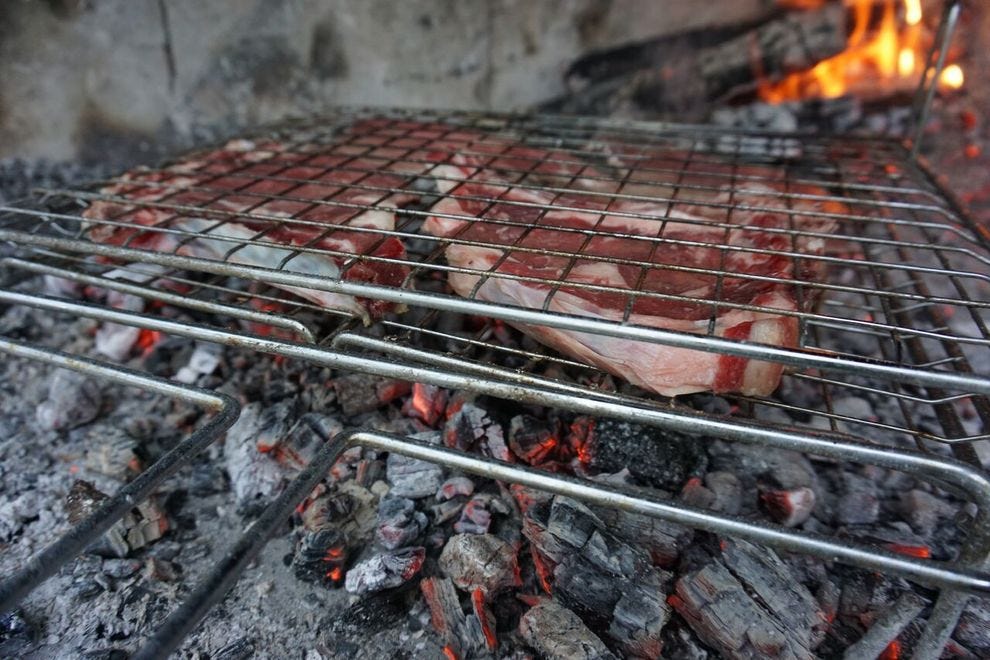Is Cooking Over Wood Safe?
Last Updated on January 20, 2020 by Duncan
Data from Anthropologists and paleontologists shows that homo erectus ate cooked food from as early as 1 million years ago. Every person and their grandma know that cooking over a fire makes the food sweet; it’s natural and fun.
According to Dr. Stephne Freedland, the director of the Center for Integrated Research in Cancer and Lifestyle (CIRCL), cooking meat at high temperatures produces heterocyclic amines (HCAs), which are cancer-causing chemicals.
When fat from the meat drips into the grill, the resulting flames cover the food with Polyaromatic hydrocarbons (PAHs), which are also linked to cancer.
Due to the reports, you might be wondering, is cooking over wood safe? Yes, it’s safe to cook over wood, but you need to take some precautions.
Things to do to reduce the risk of cancer when cooking over wood
According to Sally Scroggs, the health education manager at MD Anderson’s cancer prevention center, you can reduce the risk of colorectal cancer by making a few cooking adjustments. Some of the things you can do include:
Limit red meat
Meat from pork, beef, and lamb contains plenty of carcinogens, so you should stay away from it. Instead, go with skinless chicken breasts and fish.
Don’t char or burn the meat when cooking
As mentioned above, cooking meat at high temperatures makes heterocyclic amines (HCAs) to form. For you to be safe cooking meat on wood, you should reduce the production of HCAs.
You can do this by:
Sticking to fish: Fish cooks faster than meat and poultry. It also contains less fat
Pre-cooking the food: Before you grill the food, pre-cook it in a microwave or oven for two to five minutes. This is to reduce the time you have the food on the grill.
Lowering the temperature: You should watch the amount of wood you use in your cooking. As a rule of thumb, don’t use a lot of wood that makes a lot of fire that not only produces a lot of HCAs, but also burns the meat.
Oiling the grill: Oiling the grill prevents charred materials from sticking to the food.
Cleaning the grill: Once you are done with cooking, clean the grill. This is to prevent harmful chemicals from building up and being transferred to the food.
How to cook food over fire

With the precautions in place, you can safely cook over the fire. For you to do it, you should follow these steps:
Step 1
Start with seasoned wood. This is wood that has been air-dried for at least six months. You can season the wood or buy already seasoned wood. For best results, use hardwood such as walnut, ash, oak, or hickory.
Properly seasoned hardwood burns efficiently and hotter. It also doesn’t produce a lot of smoke.
Avoid pine or any resin-laded wood as it burns fast, creates an unpleasant taste, and acrid smoke.
Step2
Stack the seasoned wood in a teepee shape. You can easily create the shape using a starter cube. If you don’t want to use the cube, form the teepee around a small pile of kindling wood.
Step 3
Wait for the wood to burn and start breaking down into embers. This takes between 30-45 minutes, depending on the type and quality of wood.
Using a shovel, metal rake, or gardening tool, break up the red-glowing wood into chunks.
Step 4
If there is burning wood at the back of the fire pit or BBQ grill, use a shovel or any other tool to spread the embers out in an even layer at the front.
Step 5
Lay your grill on top of the embers. You can use a cast-iron grate or a lighter weight stainless steel one. It all depends on your likes and preferences.
Step 6
Place meat and vegetables on the grill with minimal seasoning. Use just a little olive oil and salt. The smoke from the wood will do the flavoring.
Step 7
You should note that you should only cook over embers, not over flames. When cooking, remember to keep on spreading more embers from the fire onto the cooking area.
Is there wood that is not good for cooking?

Yes, there is. The wood includes:
Softwoods
This is the wood from conifers such as fir, spruce, pine, redwood, and cedar. These trees contain high levels of turpenes and sap, which gives the food a funny taste, which can make you sick.
Cedar planks are popular for cooking salmon, but you shouldn’t burn the wood for smoke.
Eucalyptus, Elm, sycamore, and liquid amber give the food bad flavor, so you should avoid it.
Wood containing toxins
Some several trees and shrubs contain toxins that can be harmful to you, so you should never use the wood from the tree to cook.
Sometimes the toxins survive the burning process and end up in the meat, making you sick.
Some of the plants you should stay away from include: yew, mangrove, tambootie, laburnum, walnut, sassafras, and oleander.
Moldy wood
Old wood covered in fungus or mold will give the meat a bad taste. Some mold even contains toxins that make them dangerous to use for smoking.
Lumber scraps
Whether new or used, you should avoid lumber as it’s often chemically treated, making it poisonous to humans.
Chemically treated wood
Any chemically treated wood is dangerous to use for smoking as the chemicals can get into the food.
Other than lumber, other frequently treated wood include wood scraps from wood pellets and furniture manufacturers.
Painted or stained wood
Paint and stains make the meat taste bitter. Old paint is also more likely to contain lead, which is hazardous to humans.
When you aren’t sure
If you come across any wood that you can’t tell whether it’s suitable for smoking, don’t use it. To be safe, only use wood that has been identified to be safe. For identified wood, read this list of the best woods for smoking


